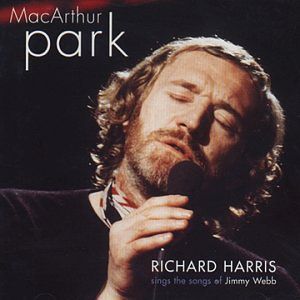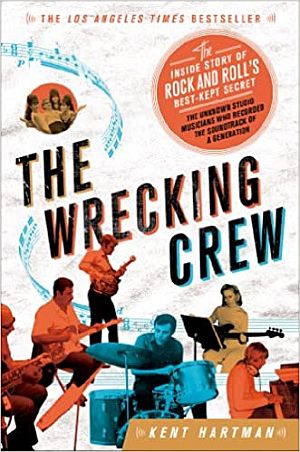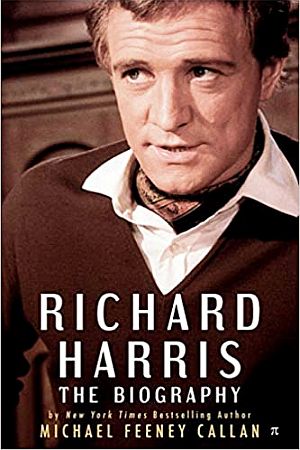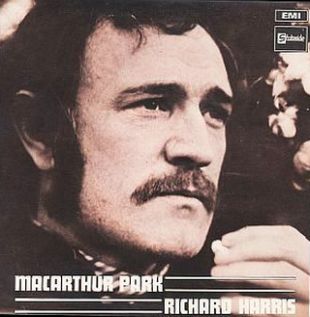
Richard Harris, an unlikely music pop star, but the Irish actor helped make “MacArthur Park” a 1968 hit. Click for digital.
Music Player
“MacArthur Park”-1968
[ lyrics below later, scroll down ]
“MacArthur Park” is actually a love song – or rather, a lament over love lost – though it might not convey that message to all listeners at first impression. The song’s lyrics, arrangement, and structure are somewhat unusual and may seem a bit confounding. But given a chance, say its fans, the song will grow on you. And indeed, in 1968 the song did grow on a great many listeners, defying the odds on several levels, as it sold more than a million copies and would win a Grammy. It would also spawn more than 100 cover versions. More on that later.
But initially, in the music business of its day, “MacArthur Park” was a hard sell and went nowhere. First, it ran more than 7 minutes at a time when 2-to-3 minutes was more the norm for pop radio play. Secondly, it was a pretty complex song musically. Third, its lyrics were baffling, confounding and/or distracting for some, and would later draw long-lived critique and parody. And fourth, it was not sung by a mainstream pop music star. Still, “MacArthur Park” rose above those supposed handicaps and became a hit in its day and would also become a hit for several other artists in later years. But added to this song’s musical and lyrical features, and perhaps more importantly, are its cast of interesting characters and storyline – including its inspiration, rejection, successful release, surprising range of covers, and its musical accolades.
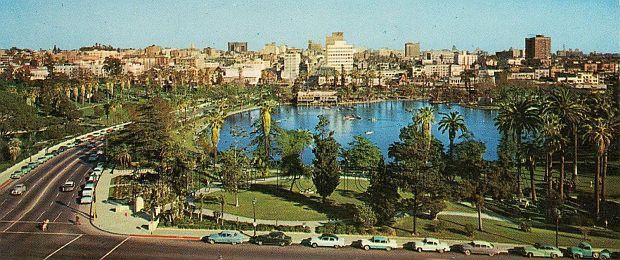
MacArthur Park post-card rendering, late 1950s, in the Los Angeles neighborhood of Westlake, where Jimmy Webb and Susie Horton shared affections in the mid-1960s, with the park’s namesake later becoming the title for the famous 1968 song.
The song’s genesis sprang from a romance between then unknown and aspiring songwriter Jimmy Webb and his girlfriend at the time, Susan Horton. Webb, who would later become a quite famous songwriter with dozens of successful songs and albums to his credit, was just starting out in 1965.

Susie Horton, undated.
MacArthur Park is located in the Westlake area of Los Angeles, near downtown. The park’s origins date to the late nineteenth century and earlier names, but by the 1940s became MacArthur Park, named for the famous military man, General Douglas MacArthur. The park has a small lake and walking paths, fronting on L.A.’s Wilshire Boulevard, and in the mid-1960s also had paddle boats and ducks.
Susie and Jimmy had begun their romance when both were high school students in Colton, California. In mid-1965, the couple met frequently at MacArthur Park for lunch and had memorable times there.
But alas, Ms. Horton ended the relationship, breaking Jimmy Webb’s heart, but inspiring him to later write “MacArthur Park” and a few other songs as well. More on all of that a bit later. First, some background on Jimmy Webb.
Jimmy Webb
Jimmy Webb was born in Elk City, Oklahoma, August of 1946, and raised in Laverne, Oklahoma. His father was a Baptist minister at rural churches in southwestern Oklahoma and west Texas. Jimmy, who had learned piano and organ by age 12 at the urging of his mother, was playing in the choir of his father’s churches, and also accompanied by his father on guitar and his mother on accordion. By the late 1950s, Webb was improvising and rearranging the hymns at his father’s churches and also began to write religious songs. And despite restrictions on the music heard at home – primarily country and white gospel music – he was drawn to and influenced by popular music he also heard, including that of Elvis Presley.
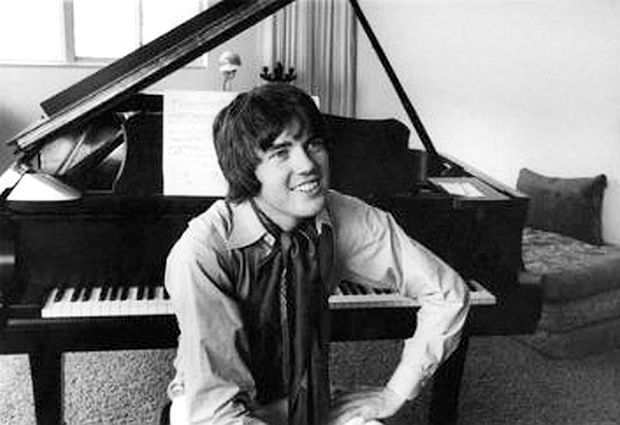
Young Jimmy Webb at piano, about 1966 – near the launch of his “boy wonder” song-writing phase.
In 1961, at the age of 14, in something of a prescient moment, he bought his first record, “Turn Around, Look at Me,” by Glen Campbell, a singer for whom he would later write hit songs. By 1964, his family moved to Southern California, and Webb would later attend San Bernardino Valley College to study music. At the death of his mother from an inoperable brain tumor, his father and siblings packed up to return to Oklahoma. Jimmy would stay in the Southern California to pursue a career in music. His father thought songwriting would break his son’s heart, but gave him the last $40 he had.
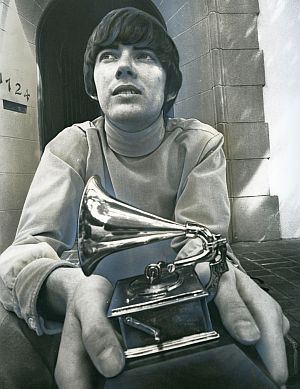
On the Rise. Webb with Grammy for “Up, Up and Away,” a hit song for The 5th Dimension. Click for their CD or singles.
In 1966 he met singer and producer Johnny Rivers, who signed him to a publishing deal and recorded his song “By The Time I Get to Phoenix” for his 1966 album Changes. Another Johnny Rivers album, Rewind, followed, with seven Jimmy Webb songs. Rivers, also a producer, had a new group named The 5th Dimension, and asked Webb to write songs for then. The result, in part, was the album that later became Up, Up and Away, including the title track “Up, Up and Away.” That song, released as a single in May 1967, became a Top Ten hit. Another 5th Dimension album followed – The Magic Garden – and was also released in 1967, featuring eleven additional Webb songs. Webb would later collect a Grammy for “Up, Up and Away” as Song of the Year and Record of the Year for 1967. So, the unknown Jimmy Webb from Oklahoma was on the rise fairly quickly in the L.A. music scene. But there was also some rejection.
In 1967, producer and recording engineer, Dayton “Bones” Howe, who also worked with the 5th Dimension, challenged Webb to write a radio-friendly song — one with classical elements, different movements, and changing time signatures. Webb undertook the challenge, crafting a four-part suite about the end of a romantic relationship. In fact, when Webb set out to work on the piece in the summer and fall of 1967, he had a long cantata in mind, even suggesting it could run for 22 minutes, or a whole side of an album. Webb’s work was later delivered to Howe with all the elements Howe had asked for.
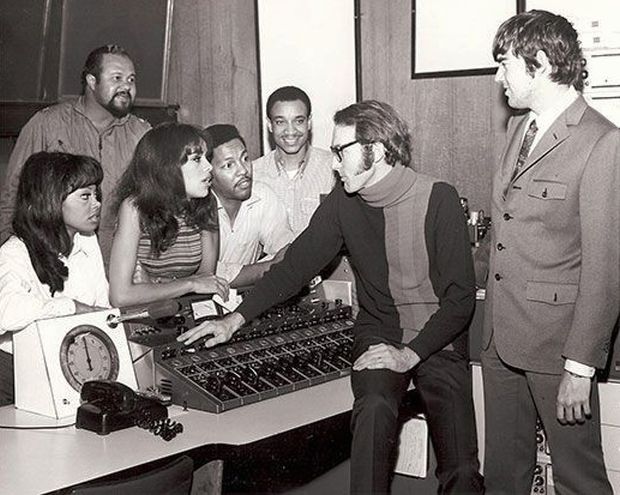
At Western Recording Studios in L.A., “Bones” Howe, seated, with members of the 5th Dimension pop recording group, left, and Jimmy Webb standing, far right, during sessions for “The Magic Garden” album. Click for 'Ultimate 5th Dimension' CD.
Howe had intended the song for a rising soft rock group, The Association, then of recent pop fame for hit songs, “Along Comes Mary”(No 7, March 1966) and “Cherish” (No 1, August 1966), among others. But when Webb auditioned his cantata for the Association, they were not thrilled with what they heard, and rejected it, especially since it would consume a whole side of an album. Webb’s arrangement and its lyrics were seen, respectively, as ambitious and unorthodox. Yet length was the major problem. So at that point, what would become “MacArthur Park” (the last 7-to-8 minute part of Webb’s cantata), went to the bottom of his song bag. But it wasn’t dead yet. The song would soon have an interesting recovery and a new trajectory.
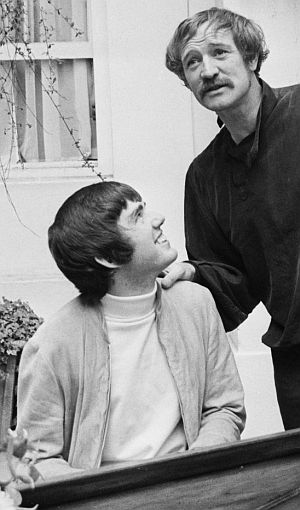
October 16, 1968. Jimmy Webb, at keyboards with Irish actor and singer Richard Harris (Larry Ellis/Daily Express).
Enter King Arthur
By late 1967, Jimmy Webb was a rising young talent on the L.A. music scene, and would find himself attending various social gatherings. At a Hollywood anti-war pageant and fundraiser in East L.A., he met Richard Harris, the incorrigible Irish actor then of rising stage and screen fame, who had just starred as King Arthur in the film version of Camelot – a role in which he also sang several songs. Harris would have later film roles, among them, The Molly Maguires, A Man Called Horse, Cromwell, and many others. In the early 2000s, Harris would become known to a younger generation for playing Dumbledore, the Hogwarts school headmaster in the early Harry Potter films.
But back in Los Angeles at the 1967 fundraiser, Harris wanted to sing old pub songs, and finding a backstage piano with Webb, the pair soon became a duo that night and drinking buddies. “He liked vodka,” Webb recalled of that evening. “And I was out of my league. Way out of my league…” But Webb noted that Harris also said to him that night: “‘Let’s make a record, Jimmy Webb’ – He only called me ‘Jimmy Webb,’ never just ‘Jimmy’.” And although Webb enjoyed the good times shared with Harris that evening, he thought nothing would ever come of Harris’ recording suggestion. But not long after, Webb received a telegram from Harris: “Jimmy Webb, come to London and make a record. Love, Richard.”
Webb then went off to London – his first time out of the country – with his songs and sheet music in tow. He ended up at Harris’ home in Belgravia, London, and when they set to work — “over pitchers of Pimm’s Cup” according to one account — Webb auditioned pieces of his songs as Harris listened to each one. But nothing clicked for Harris. Then Webb reached down into the bottom of the bag. “I looked down with some dread because there was only one thing left. I was down to ‘MacArthur Park’,” he recalled, the song rejected by Bones Howe and The Association. “By the time I played it, we had moved on to straight brandy, but [hearing the song] Richard slapped the piano [and exclaimed]. ‘Oh Jimmy Webb. I love that! I’ll make a hit out of that, I will!’”
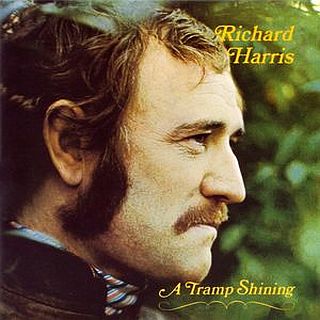
1968 Richard Harris album, “A Tramp Shining,” included “MacArthur Park” and “Didn’t We.” Click for CD.
Not only did Webb and Harris collaborate on “MacArthur Park,” they also produced an entire Richard Harris album, titled A Tramp Shining – with eleven songs by Webb who also produced it.
As noted earlier, the ambitious construction of the “MacArthur Park” song, its 7:21 minutes length, and Harris’ lack of a track record as a vocalist, all made the song a tough sell among recording labels. In fact, several labels turned it down.
But finally, Lou Adler at Dunhill Records agreed to do the single and the album. “MacArthur Park,” was released ahead of the album in April 1968. The single’s B-side song, also by Webb and Harris, and also on the album, was “Didn’t We?,” a song that would also have modest success.

A 45rpm single of Jimmy Webb’s “MacArthur Park” by Richard Harris on Dunhill Records.
A Tramp Shining also became a hit, peaking at No. 4 on the album charts in July 1968. A second Webb/Harris album followed in 1969, The Yard Went on Forever, reaching No. 27 on the Billboard albums chart. It included eight Webb compositions. One review of that album in Billboard magazine said Webb’s material was “treated with class and finesse” by Harris, and that one track, “Lucky Me,” was “a shimmering gem.”
But for Webb, it was his first love, Susie Horton, who helped stir his musical soul.
|
“Susie, The Muse” After Susie Horton broke Jimmy’s heart at MacArthur Park in 1965, she became a dancer and moved to Lake Tahoe to work in the casino showrooms. There she met another guy and fell in love. And when Susie first told Jimmy Webb that she intended to marry that guy, one result was another Webb song. This one was titled “The Worst That Could Happen,” which had been used for the 5th Dimension Magic Garden album. However, this song became a much bigger hit for Johnny Maestro & The Brooklyn Bridge, released in December 1968 and rising to No.3 by February 1969. The opening lyrics in that song may be familiar to Baby Boomers of that era: “Girl, I heard you’re getting married, heard you’re getting married…. Maybe it’s the best thing for you, but it’s the worst that could happen — to me.” There was also “Where’s the Playground Susie” (1968-69), another Susie Horton-inspired song by Webb that Glen Campbell used for a hit. Webb also wrote ‘By the Time I Get to Phoenix’ about his and Susie’s relationship (“Phoenix” was recorded first by Johnny Rivers in 1965 and more prominently, by Glenn Campbell in 1967).Susie Horton became the muse for at least four of Jimmy Webb’s hit songs. So Susie Horton – or at least the angst she stirred in Jimmy Webb’s soul – became the muse for at least four of Webb’s hit songs. Meanwhile, Susie Horton’s first marriage was short-lived, and she and Jimmy did reconnected for a time. According to Webb: “…A long time after I had written it [“MacArthur Park”] I found out she had moved to Lake Tahoe and become a dancer. When I came into some significant money, I hired a Lear jet, flew up there, and said: ‘I’m not going back without you.’ We lived together for three years. Then it turned into a soap opera….” Webb and Horton went their separate ways thereafter, married other people but remained friends. (Susie Horton married Linda Ronstadt’s cousin, Bobby in 1993). Yet it would be Webb’s “MacArthur Park” that would live through the ages. Of his song writing, Webb has said: “The territory I tend to inhabit is that sort of ‘crushed lonely hearts’ thing. The first part of a relationship is usually that white-hot center when all the happy songs come. When that’s gone it can be devastating, and that’s when the sorrowful songs come.” |
Boy Millionaire
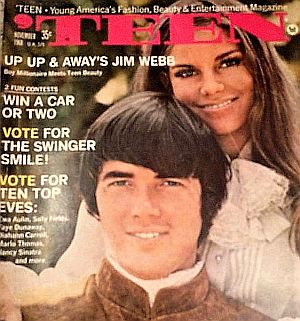
November 1968, Teen magazine: “Up Up & Away’s Jim Webb: Boy Millionaire Meets Teen Beauty”– the cover girl, Patsy Sullivan, who he would later marry. Click for copy.
At the February 1968 Grammy Awards, Webb’s songs, “By the Time I Get to Phoenix” and “Up, Up and Away,” had won a total of eight Grammys between them, and turned Jimmy Webb into the most prominent new songwriter of his generation. Webb by then had become a millionaire, and his services were much in demand. More success and accolades would soon follow.
Frank Sinatra included his version of “By the Time I Get to Phoenix” on his 1968 album Cycles. Sinatra, in fact, would praise “By the Time I Get to Phoenix” as “the greatest torch song ever written.”
In November 1968, Teen magazine, shown above, featured Webb in a cover story titled, “Up Up & Away’s Jim Webb: Boy Millionaire Meets Teen Beauty” The teen beauty he posed with was then a very young– Patricia “Patsy” Sullivan – daughter of actor Barry Sullivan and Swedish actress/model Gita Hall. Several years later, in 1974, Webb would marry Patsy Sullivan, then 17, becoming his wife of 22 years and mother to six of his children, though the couple later divorced.
Back in the 1960s, meanwhile, Webb, with his quick-won fame and wealth, had indulged in all manner of comforts, toys and diversions. Not least of these was a fondness for fast cars, including the purchase of a very rare and expensive Shelby Cobra sports car with a supercharged 427-cubic-inch V-8 engine capable of enormous horsepower and neck-snapping speed. He also bought a 1930s “valleywood” mansion and hilltop estate of many acres with pools, gardens, waterfalls, century-old white oak trees, horse stables, and more. Grand pianos, a recording studio, and a giant pipe organ were part of the interior. There he adopted something of a hippie lifestyle, living communally for a time, and becoming immersed in the world of “sex, drugs, and rock and roll.” And while Jimmy Webb had his share of very bad moments during that period, his work ethic and his love of music kept him afloat.
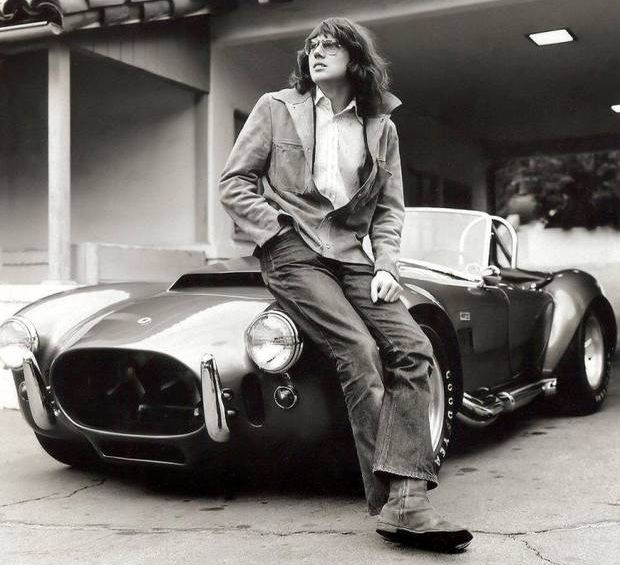
Late 1960s. Jimmy Webb in his long-hair phase, posing with his "Supersnake," high-performance, Shelby Cobra sports car.
Interviewed by Rolling Stone magazine in 1982, Webb would say of his experiences in the 1960s: “In a way, I don’t think I did survive…. Certainly, that farm kid who showed up in Hollywood with a pack of songs under his arm didn’t survive. I think I lived quite a few years in a kind of haze, because as my manager once put it, I took to marijuana like a fish takes to water. And though my strong Baptist background broke down to a certain degree, it was always inside me. For a while I really did believe I was a genius. When you read it in the press a hundred times a year, you tend to believe it. But eventually all the hype caught up with me.”
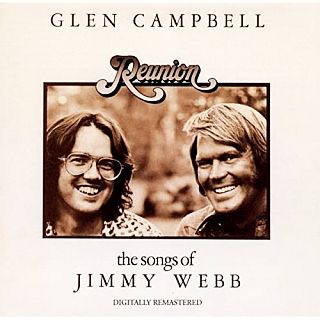
In 1974, Glen Campbell and Jimmy Webb issued a collaboration album titled, "Reunion," which featured a dozen Jimmy Webb songs performed by Glen Campbell. Album was reissued with remastered tracks in 2001. Click for CD.
When Webb and Campbell first met – during the production of a General Motors commercial – Webb had Beatle-length hair. Campbell, then seated and tuning his guitar, looked up at Webb and said, “when ‘ya gonna get a haircut?” Still, Webb’s songs were especially successful for Campbell, and the two had a long collaboration, producing, among others: “By the Time I Get to Phoenix”(1967), “Wichita Lineman”(1968), “Galveston”(1969), “Where’s the Playground Susie”(1969), and others. At the 1969 Grammy Awards, Webb accepted awards for “By the Time I Get to Phoenix”, “Wichita Lineman” and “MacArthur Park”.
In addition to Glen Campbell, there was a long line of other artists who would record Jimmy Webb’s songs through the late 1960s and early 1970s. In 1968 Nina Simone and Bobby Vee did versions of Webb’s song, “Do What You Gotta Do.” Also in 1968, when Webb and his father were in Las Vegas for a visit, they attended a Frank Sinatra show at one of casinos there. Sinatra at one point during the show had Jimmy stand up in the audience and take a bow, and then performed Webb’s song, “Didn’t We?” Sinatra would also include that song on his acclaimed 1969 album, My Way.
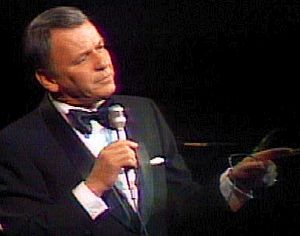
Frank Sinatra would prove to be a big Jimmy Webb fan, incorporating some of his songs in his shows and on his albums. Click for Sinatra’s 1969 “My Way” album.
In January 1970, “Honey Come Back” by Webb charted at No. 19 for Glen Campbell. In April that year, “The Girls’ Song” by The 5th Dimension hit No. 43. And in September 1971, Motown’s Four Tops had a No. 38 hit with their version of “MacArthur Park.” Barbra Streisand charted at No. 82 in December 1972 with “Didn’t We?” And in September 1973, Art Garfunkel had a No. 8 hit with “All I Know.” British rocker and bluesman, Joe Cocker, had a No. 5 hit in 1975 with Webb’s “It’s a Sin When You Love Somebody.”
Meanwhile, Webb himself would try recording his own songs in the 1970s, something he would continue doing throughout his career, issuing a number of his own albums and performing live concerts. Yet his songwriting for others, and extensive cover versions of his songs, would remain at the center of his successful career. And not least in the Webb discography would be the numerous cover versions of “MacArthur Park” – the song that also continued to spark questions, varied interpretation, critique, and parody.
MacArthur Redux

Late 1970s. Cover sleeve for Donna Summer single of “MacArthur Park” issued in France. Click for digital.
Music Player
“MacArthur Park”-1978
Donna Summer
Released in September 1978, Summer’s vinyl single of “MacArthur Park” arrived at No. 1 on the Billboard Hot 100 the week of November 11, 1978 and it held that position for three weeks. It became a million seller again and also earned Summer her first nomination for the Grammy Award for Best Female Pop Vocal Performance.
Summer would have two recordings of “MacArthur Park.” One was an 8:40 minute version included as part of a “MacArthur Park Suite” on her double album, Live and More. A shorter version – for the seven-inch vinyl single, running 3:56 – was the disco-dance hit version, the song that went to No. 1 on Billboard. It was shorter than the Richard Harris version, with the ending stanzas omitted and some minor variation in the lyrics.
But Donna Summer wasn’t the only one who covered the song. In fact, “MacArthur Park” was subsequently covered by numerous artists – more than 150 by some counts. Among those offering their interpretations have been: Tony Bennett, Liza Minnelli, Dionne Warwick, Andy Williams, Sammy Davis Jr., The Letterman, Frank Sinatra, Nancy Sinatra, Glen Campbell, Rod McCuen, the Ray Charles Singers, Elaine Page, Diana Ross & The Supremes, Carrie Underwood, and others. Instrumental and jazz versions have been offered by: Ferrante & Teicher, Percy Faith, Floyd Cramer, Stanley Turrentine, Doc Severinsen, Francis Lai, Woody Herman, Stand Kenton, Maynard Ferguson and others.
|
“MacArthur Park” Spring was never waiting for us, girl MacArthur’s Park is melting in the dark I recall the yellow cotton dress MacArthur’s Park is melting in the dark… There would be another song for me I will drink the wine while it is warm I will take my life into my hands and I will use it And after all the loves of my life MacArthur’s Park is melting in the dark… |
But for Jimmy Webb, the one nagging element of this otherwise successful song was the ongoing puzzlement about, and often harsh critique of, the song’s lyrics – from innocent queries and misunderstandings to outright “worst ever” designations. The song has been spoofed by “Saturday Night Live” and “The Simpsons,” and included in Dave Barry’s Book of Bad Songs.
There is also one cleverly-done parody advertisement on the web, with the headline, “Found: Cake, Possibly Metaphorical, In Local Park, After Storm, Left by Someone (Deliberately?).” The comical ad, done in cake-icing green, picturing cake on platter with a slice or two removed, has much more tongue-in-cheek text, offering a non-malicious send up.
“People have very strong reactions to the song,” Webb would acknowledge in one Los Angeles Times interview. “There’s been a lot of intellectual venom.”
In other interviews, he would say: “I see it as a relatively simple love song with some very sad imagery and about things passing away and never being the same again. I’ve always been amazed that people find that such a mystery.”
On the internet, meanwhile, some critics have honed-in on specific lyrics. Asks one: “what the hell does a striped pair of pants have to do with love’s hot, fevered iron? Is Jimmy Webb writing about love or laundry?”
The most famous lyrical verse in the song is the repeated chorus, “MacArthur Park is melting in the dark, all the sweet, green icing flowing down,” explained by the fact that “someone left a cake out in the rain.” But the apparent tragedy, as the narrator sings it, is, “I’ll never have that recipe again…”
“It’s clearly about a love affair ending,” Webb has said, “and the person singing it is using the cake and the rain as a metaphor for that. OK, it may be far out there, and a bit incomprehensible, but I wrote the song at a time in the late 1960s when surrealistic lyrics were the order of the day.” Never having the recipe again means never again having the elements of that particular relationship.
For Webb, the image of a cake in the rain struck him as a great metaphor for “losing a chapter of your life.” But nothing in the song is fabricated, Webb has said. “…The old men playing checkers by the trees, the cake that was left out in the rain, all of the things that are talked about in the song are things I actually saw. And so it’s a kind of musical collage of this whole love affair that kind of went down in MacArthur Park.”
Naysayers aside, “MacArthur Park” and Jimmy Webb have their admirers. AllMusic.com’s Mark Deming has observed, “MacArthur Park’s” lyrics, “although not psychedelic, were as rich and ornate as anything the Beatles or the Beach Boys had created,” adding that Webb’s arrangement “was a vast sonic canvas, combining the sounds of a rock combo and a full orchestra and choir….” Others who have studied the harmonies and chords of “MacArthur Park,” acknowledge that Jimmy Webb broke new ground with this song.

Young Jimmy Webb working with orchestra, possibly during a "MacArthur Park" session in the late 1960s. Photo, Henry Diltz.
“I think one of the real, real geniuses is Jimmy Webb,” songwriter Sammy Cahn has noted. “His ‘MacArthur Park’ is a major piece of work, major. I’d almost compare it to Gershwin’s ‘Rhapsody in Blue’ in size and scope.” A 2018 ranking of the “100 Greatest Songs of All Time” by The Telegraph in London, placed “MacArthur Park” by Richard Harris at No. 85. As for the song’s length – “MacArthur Park” at 7:21 minutes became the longest single at that time to ever become a Top Ten hit – Beatles’s producer George Martin would note that “MacArthur Park” cleared the way for “Hey Jude,” a No. 1 song of July 1968, which ran for 7:11 minutes.
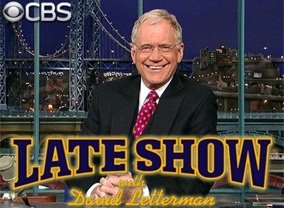
In July 2014, "MacArthur Park," Jimmy Webb, and full orchestra were featured on David Letterman's show. Click for book, “Letterman: The Last Giant of Late Night”.
“They rehearsed and planned this segment for months, and the producer said it’s maybe only the second time in history that David brought in a whole symphony orchestra. He made a huge deal of it. They called the whole night ‘MacArthur Park Night.’ They even had a big cake — with sweet, green icing — that Will Lee climbed at the end, playing the guitar and singing.
“The whole thing was a tiny bit tongue-in-cheek, but it was a huge tribute to the song and how much David liked it, and he wanted his son to understand the song. It was an unbelievable thing — everyone was so excited about it. We got a handwritten note from David a couple of days later thanking us and saying what an incredible experience it was for him.”
The full tape of that performance on the David Letterman Show that night is available at YouTube.com.
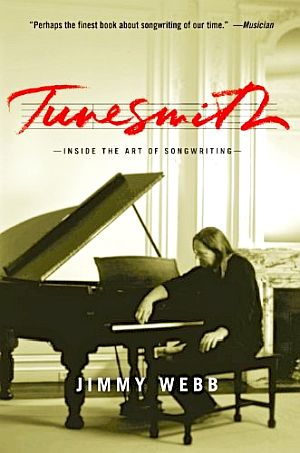
Jimmy Webb’s 1998 book, “Tunesmith: Inside the Art of Songwriting,” touted as one of the best books on songwriting. Hachette Books, 448 pp. Click for copy.
Jimmy Webb was inducted into the Songwriters Hall of Fame in 1986 and the Nashville Songwriters Hall of Fame in 1990. He received the National Academy of Songwriters Lifetime Achievement Award in 1993, the Songwriters Hall of Fame Johnny Mercer Award in 2003, the ASCAP “Voice of Music” Award in 2006, and the Ivor Novello Special International Award in 2012. According to BMI, his song “By the Time I Get to Phoenix” was the third most performed song in the fifty years between 1940 and 1990. In 2019, “Wichita Lineman” was added to the National Recording Registry. He has also written a highly-regarded book on songwriting, titled, Tunesmith: Inside The Art of Songwriting, shown at left.
In 2017, Webb completed a partial autobiography titled, The Cake and the Rain: A Memoir, published by St. Martin’s Press. The book provides some insight into “early Jimmy Webb,” flush with success and wealth, living in the fast lane, being paid in Corvettes for some work (yes, Chevrolet Corvette sports cars), and mingling with all manner of musical cognoscenti, whether Elvis Presley and Frank Sinatra, or Joni Mitchell and John Lennon– and many more.
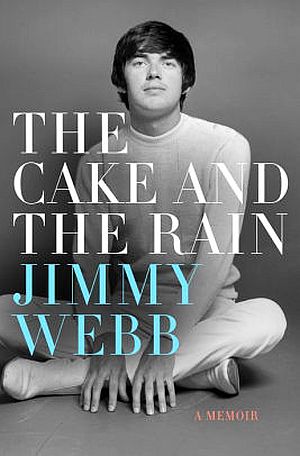
Cover of Jimmy Webb's 2017 memoir, "The Cake And The Rain," St. Martin's Press, 352 pp. Click for copy.
…By the time we got back to Los Angeles, Caesars Palace had offered me an eight-week engagement — forty thousand dollars, three times a year. Management wanted me to play an instrumental version of “MacArthur Park” on a white piano once a night “like Liberace.” They didn’t want any singing; singing would pay less.
I turned the deal down. I wanted to be part of the world that my peers inhabited. The world I’d experienced at the Monterey Pop Festival, playing with Johnny Rivers and the Wrecking Crew. Real rock ‘n’ roll and higher- consciousness types did not play Vegas in 1969. I faced a significant divergence in life’s river…
Also described in this book, is Webb’s encounter with supplying drugs to John Lennon and Harry Nilsson during one night of their infamous “lost weekend” in the early 1970s, and another episode that resulted in a near-death, PCP-laced drug experience for Webb and a long recovery. His Oklahoma/Baptist heritage would later reclaim him.
Still, despite the stumbles, Webb’s star shone brightly in those early years, and later too, leaving a very fine trove of musical accomplishment for the ages. The book doesn’t cover his entire career – only through 1973 – and in view of some readers, does not reveal enough about the details of his songwriting successes. There is, however, one index that runs for 11 double-column pages bearing the names of all those artists who have performed or recorded his songs. Webb’s original manuscript for this book ran to 300,000 words or so, of which the publisher used about 100,000. So, there is more yet to come. Stay tuned.
For additional stories at this website on song histories, songwriters, and artist biography, see the “Annals of Music” category page. Thanks for visiting – and if you like what you find here, please make a donation to help support the research, writing and continued publication of this website. Thank you. – Jack Doyle
|
Please Support Thank You |
____________________________________
Date Posted: 7 June 2020
Last Update: 6 February 2023
Comments to: jdoyle@pophistorydig.com
Article Citation:
Jack Doyle, “MacArthur Park …And Jimmy Webb,”
PopHistoryDig.com, June 7, 2020.
____________________________________
Sources, Links & Additional Information
“MacArthur Park (song),” Wikipedia.org.
“Jimmy Webb,” Wikipedia.org.
Mark Deming, “Jimmy Webb, Artist Biogra-phy,” AllMusic.com.
“MacArthur Park” (the park), Wikipedia.org.
Scott Johnson, “Sunday Morning Coming Down” [Jimmy Webb story], PowerlineBlog .com, February 5, 2023.
Hadley Meares, “MacArthur Park’s Glory Days: It Reigned for a Half-Century as a Grand Setting for Outdoor Concerts and Boat Rides,” LA.Curbed.com, January 19, 2018.
“Up Up & Away’s Jim Webb: Boy Millionaire Meets Teen Beauty,” Teen Magazine, November 1968.
Geoff Boucher, “‘MacArthur Park’ Jimmy Webb | 1968,” Los Angeles Times, June 10, 2007.
“Jimmy Webb, Born: 8 / 15 / 1946,” Oklahoma Music Trail, TravelOK.com.
Randy Lewis, “Muse For Jimmy Webb’s ‘MacArthur Park’ Treasures Those Days,” Los Angeles Times, July 20, 2013.
Dave Simpson (interview with Jimmy Webb), “How We Made MacArthur Park. Songwriter Jimmy Webb Recalls Recording the Somewhat Infuriating Suite with Actor Richard Harris, and The Real Story Behind Leaving That Cake Out in the Rain,” TheGuardian.com, Novem-ber 11, 2013.
“The Yard Went On Forever,” Wikipedia.org.
“Billboard Album Reviews,” Billboard, Nielsen Business Media, Inc. 80 (44): 76. November 2, 1968.
“Jimmy L. Webb,” The New Yorker, January 9, 1971.
“Jimmy Webb Discography,” Wikipedia.org.
“The Magic Garden,” Wikipedia.org.
Scott K. Fish, “Jimmy Webb: The Goal is Originality,” The Mix, September 1983, Vol.7, No.9.
Scott K. Fish, “Jimmy Webb: The Pragmatics of Ignorance,” ScottkFish.com, December 6, 2015.
Scott K. Fish, “Jimmy Webb: I Didn’t Have Any Kind of a Gift,” ScottkFish.com, July 3, 2016.
Dan MacIntosh, “Songwriter Interviews: Jimmy Webb,” SongFacts.com. May 16, 2011.
“Readers’ Poll: The Worst Songs of the Sixties; Selections Include ‘I Got You Babe,’ ‘Revolution 9’ and ‘Tiptoe Through the Tulips’,” Rolling Stone, November 16, 2011.
Kent Hartman, “The Hidden History of a Rock ’n’ Roll Hitmaker. Bassist Carol Kaye Blazed Her Own Trail, as the Only Female Studio Musician to Record Some of the Greatest Songs of the ’60s and ’70s,” Smithsonian Mag.com, February 28, 2012.
Kent Hartman, The Wrecking Crew, St. Martin’s Press, 2012.
Fred Bronson, “MacArthur Park; Donna Summer, Week of November 11, 1978,” The Billboard Book of Number One Hits, Billboard Books, 2003.
Greta Sproul “MacArthur Park: The Song That Launched a Thousand Parodies,” The Shal-lows (blogspot.com), March 26, 2012.
Michael Starr, “Jimmy Webb Tune Will Take Another Turn on ‘Late Show’,” NYPost.com, July 16, 2014.
Alan H. Fallick, “Jimmy Webb Discusses Famous Lyrics in ‘MacArthur Park’,” News-day.com, October 8, 2014.
Luisa Yanez, “Fifty Years Ago, ‘The Worst Song Ever Written’ Hit the Radio. Now Donna Summer Is Reviving It — Again,” Miami Herald.com, April 29, 2018.
Randal Hill, “‘MacArthur Park’– Richard Harris, July 1968,” Senior Life / VieraVoice .com, June 28, 2018.
“MacArthur Park by Richard Harris,” Second HandSongs.com.
“Paul Shaffer + CBS Orchestra w/ Jim Webb -‘MacArthur Park’ on Letterman,” YouTube .com, July 22, 2014.
Jon Dolan, “Jimmy Webb on John Lennon’s Lost Weekend, Writing for Frank Sinatra; Veteran “Songwriter Recalls His Hard-Partying Early Days, Brushes with The Beatles and Other Career Highs and Lows Chronicled in New Memoir,” RollingStone.com, April 18, 2017.
Here and Now / “Songwriter Jimmy Webb On Glen Campbell: ‘He Really Taught Me A Lesson In Bravery’,” KGOU.org, May 2, 2017.
Brandy McDonnell, “Oklahoma Songwriter Jimmy Webb Returns to Home State to Sign New Memoir ‘The Cake and the Rain’, Oklahoman.com, May 7, 2017.
Dominic Green, “Jimmy Webb’s Rise and Fall; The Cole Porter of the ’60s Only Wanted to Be a Rock Star,” Book Review: ‘The Cake and the Rain’,” Wall Street Journal, June 23, 2017.
George Varga, “Jimmy Webb Talks Music, Drugs, His New Book and ‘MacArthur Park’,” SanDiegoUnionTribune.com, July 16, 2017.
Johnny Rogan, “Jimmy Webb’s Remarkable Memoir Has its Cake and Eats It. The Songwriter Behind ‘Wichita Lineman’ Has a Hell of a Story to Tell – and What a Cast,” IrishTimes.com, November 18, 2017.
Roger Norris, “A Lineman For His Country. An Interview With Jimmy Webb, One of America’s Greatest Storytellers in Music,” NeighbourhoodPaper.com, Sydney, Australia.
Sue Cameron, Hollywood Secrets and Scandals, 2018, BearManor Media, 378 pp.
Fred Bronson, “MacArthur Park; Donna Summer, Week of November 11, 1978,” The Billboard Book of Number One Hits, Billboard Books, 2003.
Michael Feeney Callan, Richard Harris: Sex, Death & the Movies, 2003, Robson Books, 355 pp.
Cliff Goodwin, Behaving Badly: A Life of Richard Harris, 2004, Virgin Pub, 256 pp.
Michael Sheridan, Anthony Galvin, A Man Called Harris: The Life of Richard Harris, 2013, The History Press, 224 pp.
_______________________________________
